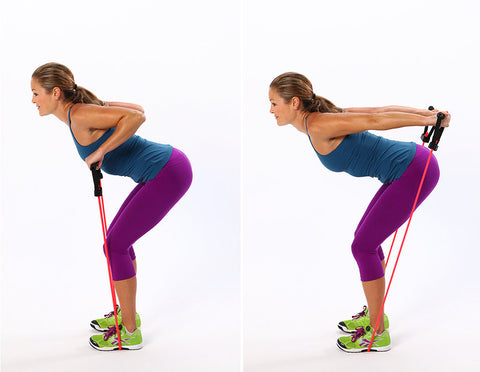100% of beginners will use the resistance band wrong
Resistance bands are a great strength training exercise. It is made of rubber, a very strong rubber band. Some have handles, some are just a strap. It comes in different strengths and sizes, and the harder it is to pull, the harder it is to train.
Don't underestimate this resistance band, it may be a better way of strength training:
•cheap price.
• Not limited by location, can be used anywhere. Easy to carry, you can take it with you wherever you go. You can use it at work or watching TV.
• They are so adaptable that a single resistance band can train the whole body. If you want to increase the difficulty, you can train with two resistance bands.
Experts recommend strength training at least twice a week, along with 150 minutes of aerobic activity per week, such as walking, jogging, or cycling.
A good training plan is to do 15 reps of each exercise for 2 sets.
Training suggestions:
Biceps curl (training upper arms)

1. Hold both ends of the resistance band with both hands
2. One foot on the resistance band
3. Slowly lift the forearm up from the elbow and stretch the resistance band (pay attention to keep the upper arm close to the body, do not move)
4. Slowly lower the forearm
Triceps flexion and extension (training upper arms)

1. Hold both ends of the resistance band with both hands
2. Step on the resistance band with both feet
3. Relax the arm to make the forearm and forearm into an L shape
4. Slowly lift the forearm from the elbow to the back and stretch the resistance band until the arm is straight (be careful to keep the upper arm close to the body, do not move)
5. Slowly retract the forearm
Chest press (training the chest muscles)

1. Wrap the resistance band around the back and let it pass through the armpit
2. Hold both ends of the resistance band with both hands
3. Slowly push the arm forward, keeping it parallel to the ground, until the arm is straight
4. Slowly pull the arm back
Deltoid Pullback (Training the Upper Back)

1. Hold both ends of the resistance band with both hands
2. Put your arms straight in front of your chest, keeping them parallel to the ground
3. Extend the arms to the sides and stretch the resistance band
4. Slowly pull the arm back
Seated rowing (trains the upper back, shoulders and neck)

1. Sit in a sturdy, armless chair
2. Hold both ends of the resistance band with both hands
3. Wrap the resistance band around your feet and place the resistance band flat on the ground
4. Begin with your hands by your feet
5. Pull your elbows back up until your hands are close to your hips
6. Slowly bring the arms back to the starting position
Resistance squat (training the legs)

1. Hold both ends of the resistance band with both hands
2. Step on the resistance band with both feet
3. Raise your arms to shoulder height
4. Squat, like sitting on a chair, with your knees not over your toes
5. Get up
Calf bending (training the legs)

1. Tie the resistance band into a circle
2. Stand with your feet in the circle with the resistance band around your ankles
3. Hold the back of the chair to maintain balance
4. Put your weight on one foot
5. Lift the other foot and bend it to the hip to feel the resistance of the stretch band
6. Put your feet down
7. Repeat with the other leg
Precautions
• For diabetics, talk to your doctor first, especially if you have any kidney or eye problems
• Don't push too hard, stop immediately if you experience pain during exercise
• Don't hold your breath. Exhale when you stretch hard and inhale when you relax
• Keep your movements slow and steady. Generally speaking, it takes 3 seconds for the stretching process and 3 seconds for the relaxation process, so as not to let the resistance band bounce.
• Choose the right resistance intensity. Generally, it makes the movement a little harder, rather than easy or painful.
(The pictures are all from the Internet)
Evidence-based sources :
American Diabetes Association: "What We Recommend."
Joslin Diabetes Center: "Resistance Band Routines and Diabetes," "Resistance Band Training for Arms," "Resistance Band Training for Legs," "High-Resistance Squat."
National Institute on Aging: "Exercise & Physical Activity: Your Everyday Guide from the National Institute on Aging."
American College of Sports Medicine: "A Strength Training Program for Your Home."
American Council on Exercise: "Whole-Body Exercise Band Workout."
Canadian Diabetes Association: "Introductory Resistance Program."






